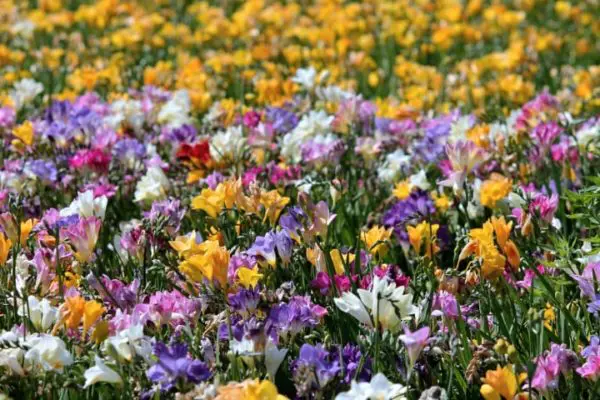Freesia flowers are known for their vibrant colors and intoxicating fragrance, making them a beloved choice for both beginner and expert gardeners. These herbaceous plants, native to Africa, are low-growing and bloom beautifully from corms (solid bulbs). If you’re looking for flowers that add elegance and a wonderful scent to your home or garden, freesia flowers are a fantastic option. In this guide, you’ll learn how to grow and care for these stunning blooms and discover some of the best freesia varieties.
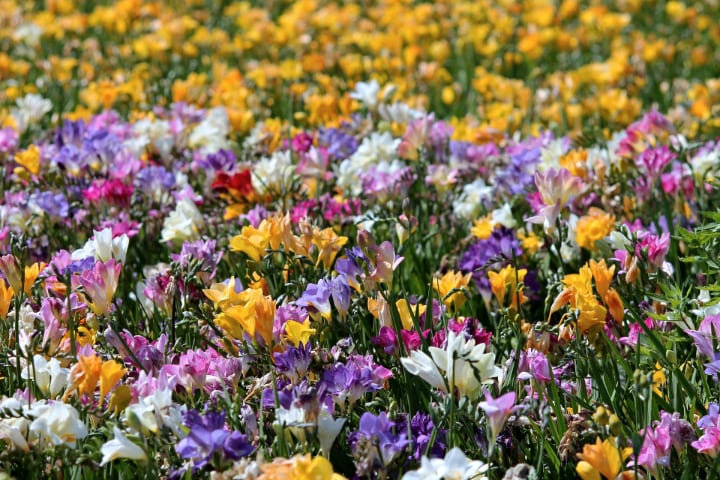
How to Grow Freesias
Growing freesias is easy as long as you consider your climate and plant them at the right time. Whether you’re planting them in your garden or indoors, here are some simple steps to get you started:
How to Plant Freesias in the Garden

- Step 1: Choose a Sunny Spot
Freesias need plenty of sunlight to grow and produce beautiful flowers. Find a sunny location in your garden for the best results. - Step 2: Plant the Corms
Plant the corms about two inches deep and space them slightly apart. Position the pointy side of the corms up. For a fuller effect, group your freesias in bunches of seven. - Step 3: Water and Add Mulch
After planting, water the corms well. Cover the area with mulch to help retain moisture. - Step 4: Use a Support
As freesias are lightweight, their stems might not always be able to bear the weight of many flowers. Consider using a support system to keep them upright. - Step 5: Trim the Foliage
Once the freesias bloom in the spring, trim the foliage but don’t discard it, as the plants will enter dormancy. - Step 6: Remove the Corms
Since freesias are not cold-hardy, it’s best to remove the corms after the leaves fall. Let them dry, then clean off any shriveled parts. - Step 7: Replant the Corms in Spring
Store the corms in a cool, dry place (protected from frost) until spring. You can plant them again once the weather warms up.
How to Grow Freesias from Seed
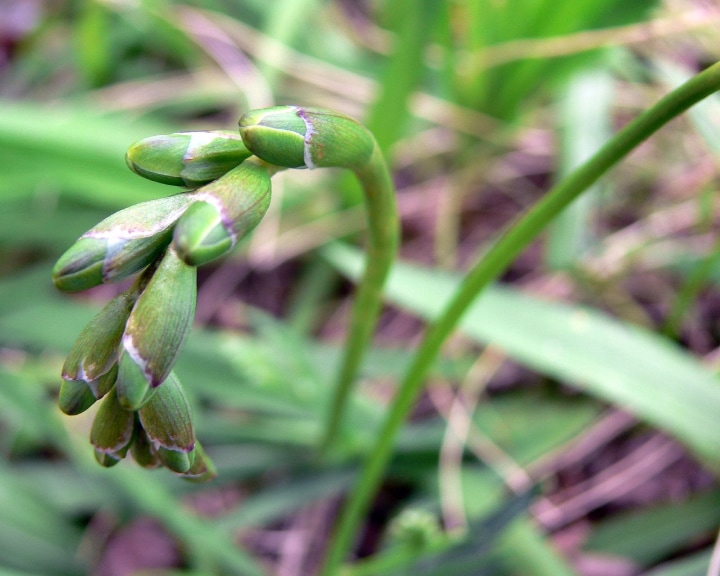
While growing freesias from corms is the easiest method, you can also grow them from seeds. Here’s how:
- Let the seed pods ripen on the plant after blooming (usually in summer).
- Once the pods turn brown and show vertical lines, collect the seeds.
- Dry the seeds in a paper bag for a few days and sift them to remove any small seeds.
- Before planting in spring, soak the seeds for a day in warm water.
- Sow the seeds in trays with compost and keep the tray moist. The seeds should sprout after about a month.
- Wait until the seedlings grow true leaves before transplanting them into pots.
- Keep the seedlings outdoors between 55-65°F (13-18°C) before planting them in the garden.
How to Grow Freesias in a Pot
Freesias are also great for pot gardening. Here’s how to do it:
- When to Plant: Plant freesia bulbs in early spring in a pot. If you live in a warmer zone, you can plant in the fall but make sure they go dormant in winter.
- Pot Size: Choose a shallow pot that’s at least three times the height of the corm.
- Soil: Fill the pot with a mix of two parts compost and one part grit, ensuring good drainage.
- Light: Keep the pot in a shaded, cool place until the corms sprout, then move it to a sunny window.
- Watering: Freesias like to be watered regularly but don’t let them sit in soggy soil.
- Fertilizing: Use a balanced fertilizer or a high-potassium one when the sprouts first appear and again when the buds form.
Freesia Care Tips
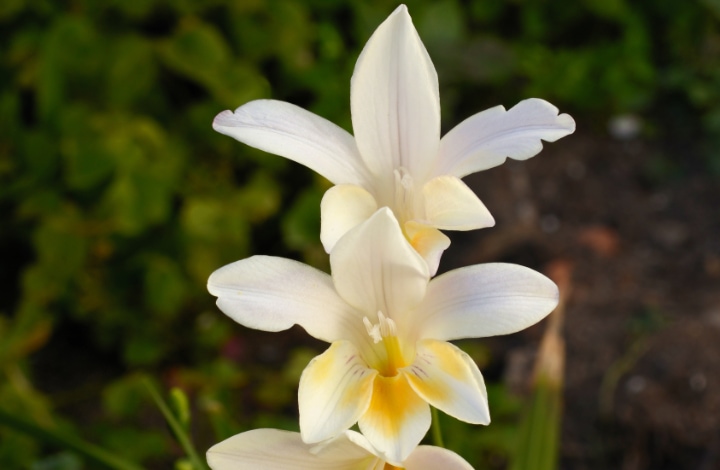
Here are some essential care tips to keep your freesia flowers healthy and vibrant:
- Soil: Freesias prefer sandy or stony soils, but they grow well in fertile, well-draining soil. If planting in a pot, use a mix that promotes aeration and drainage.
- Light: These flowers thrive in full sun to light shade. Avoid planting them in areas that are blocked by walls or trees that block sunlight.
- Temperature: Freesias are not cold-hardy and need a minimum of 50-55°F (10-13°C) at night for healthy bulb formation. They will not survive if temperatures drop below freezing, so make sure to dig them up and store them in a cool, frost-free location during winter.
- Watering: Keep the soil moist when the plant is sprouting, and water once a week while it’s blooming. Freesias prefer moderate humidity, so adjust watering if you live in a dry climate.
- Fertilizing: Apply a high-potassium or balanced fertilizer every two weeks when the sprouts emerge and again when the buds start to form. If you’ve planted in good soil, you might not need much fertilizing.
Popular Freesia Varieties
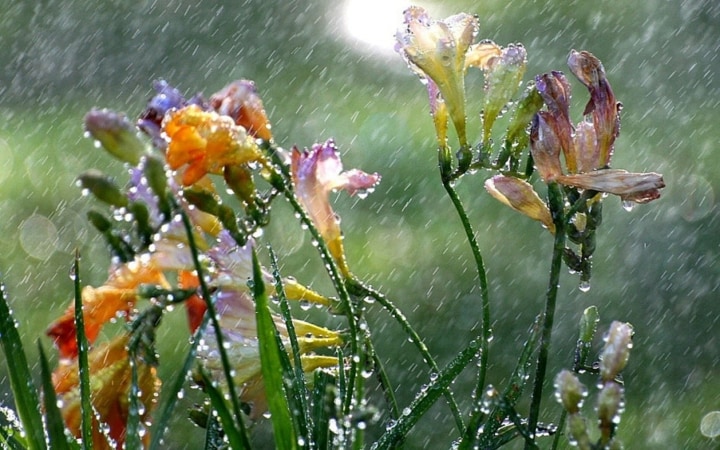
Now that you know how to care for freesias, let’s take a look at some of the most beautiful and fragrant varieties you can plant:
- Speedy White
A fast-growing freesia with white petals and yellow centers, perfect for any garden or pot. - Algarve
This delicate variety features light blue and white petals with purple edges, ideal for containers and borders. - Golden Passion
With vibrant yellow flowers and up to 10 blooms on one stem, this variety makes a striking addition to any space. - Oberon
Yellow petals with red tinges make the Oberon freesia a favorite among flower enthusiasts. - Pink Attraction
This freesia has beautiful pale pink to deep pink petals that curl beautifully around each other, creating a rich and layered look. - Honeymoon
A romantic variety with blush pink and white hues, perfect for weddings and engagements. - Corvette
With its subtle scent and large white petals, Corvette freesias are fast-growing and stunning in any arrangement. - Vienna
Creamy white with yellow centers, this easy-to-grow variety is perfect for borders and mixed flower beds. - Joan Evans
This white freesia has distinctive raspberry-like marks on its lower petals, giving it a unique look. - Alba
A hardy, all-white variety with yellow accents, perfect for cold regions or coastal gardens. - Ambassador
Large, white blooms that are perfect for arrangements, especially when paired with brightly colored flowers. - Virginia
The epitome of purity and innocence, this all-white flower also boasts a wonderful fragrance. - Ballerina
A creamy-white freesia with dense petals, ideal for bouquets and table arrangements. - Purple Rain
With vivid colors and a contrasting yellow-green center, Purple Rain is a vibrant choice for pots or containers.
Freesias are a fantastic choice for both indoor and outdoor gardens. Whether you’re looking to fill a vase or brighten up your garden, these fragrant flowers are sure to impress. Just follow the care tips, choose the right variety, and enjoy the beauty of freesia blooms year after year!
Frequently Asked Questions (FAQs)
1. When is the best time to plant freesias?
- The best time to plant freesias is in early spring. If you live in a warmer climate, you can also plant them in the fall, as long as they go dormant during the winter months.
2. Can I grow freesias indoors?
- Yes, freesias can be grown indoors in pots. Place them in a sunny window, ensuring they receive enough light to bloom. Indoors, they should be kept in a cool location during the initial growth phase before moving them to a sunny spot once the corms sprout.
3. How often should I water freesias?
- Freesias prefer moderately moist soil. Water them regularly, but avoid waterlogging. Once a week should suffice while they’re blooming, but make sure the soil is well-draining to prevent root rot.
4. How do I store freesia corms during the winter?
- After the flowers have faded and the leaves fall off, carefully dig up the corms. Allow them to dry for a few days, then store them in a cool, dry, frost-free location until spring. This will protect them from freezing temperatures.
5. Do freesias need special soil conditions?
- Freesias prefer well-draining, sandy, or stony soil. If you’re planting them in a pot, use a mix that promotes good drainage. They do well in fertile soil but need to avoid heavy, waterlogged conditions.
6. Can I grow freesias from seed?
- Yes, although it’s more common to grow freesias from corms, you can also start them from seed. After the seed pods ripen, collect and dry the seeds. Soak them before planting, and sow in trays with moist compost. It can take a few weeks for seeds to sprout.
7. What are the best varieties of freesia for beginners?
- Speedy White and Vienna are great beginner-friendly varieties. They grow easily, have a wonderful fragrance, and are relatively low maintenance. Golden Passion is another good choice for its vibrant color and easy-growing nature.
8. Why aren’t my freesias blooming?
- There are a few reasons freesias might not bloom: insufficient sunlight, overwatering, or planting the corms too deep. Ensure they’re planted in a sunny spot, with well-draining soil, and avoid overwatering, especially when the plants are not actively growing.
9. Can freesias tolerate cold weather?
- Freesias are not cold-hardy and should be protected from freezing temperatures. If you live in a cold climate, you’ll need to dig up the corms after they bloom and store them until the next growing season.
10. How can I encourage freesias to bloom more?
- To encourage more blooms, provide adequate sunlight (6+ hours per day), water regularly without overwatering, and use a high-potassium fertilizer during the growing season. Deadheading the flowers once they fade can also promote additional blooms.
Conclusion
Freesias are stunning, fragrant flowers that can be easily grown both indoors and outdoors. Whether you’re planting them in your garden or in a pot, they add vibrant color and an irresistible fragrance to any space. By following the steps to plant and care for freesias, such as choosing the right location, providing adequate sunlight, and ensuring proper watering and fertilization, you can enjoy their beauty year after year. From the beginner-friendly Speedy White to the romantic Honeymoon variety, there’s a freesia for every garden or indoor space. With the right care, you’ll soon be rewarded with beautiful blooms and a delightful scent that will enhance your home and garden.

